- Yokohama-shi Top Page
- Municipal Government Information
- Policy and Initiatives
- Major Initiatives
- Base measures
- History of Requisition
- Requisition after the war and return of urban areas (Showa 20 (1945)-Showa 36 (1961)
Here's the text.
Requisition after the war and return of urban areas (Showa 20 (1945)-Showa 36 (1961)
Last Updated July 2, 2024
Requisition by Allied Forces and Delayed War Damage Recovery
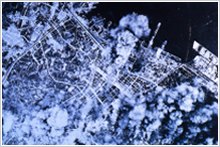
An urban area surrounded by fierce fire. The Great Yokohama Air Raid caused severe damage to 3,650 people dead and more than 300,000 people affected.
In 1945, the Allied forces stationed after World War II requisitioned a wide range of central Yokohama and port facilities. Requisition survived the war and extended from slightly remaining urban houses, offices, theaters, and department stores to public facilities such as government offices, schools, and parks, and the city's urban functions almost paralyzed. In addition to the center, former military facilities were requisitioned on a large scale.
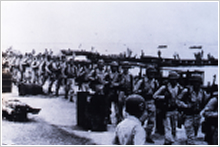
The eighth army of the United States started landing from Osanbashi.
Of the 400,000 occupying forces, about 100,000 people were stationed in Yokohama.
As a result, the head offices of trading companies, financial institutions and companies that supported the pre-war Yokohama economy were forced to relocate to Tokyo and other regions, and along with the requisition of port facilities such as Osanbashi, Yokohama lost its economic base, which should serve as a driving force for reconstruction.
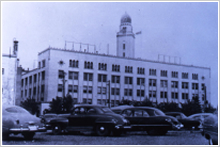
The Yokohama Customs had a temporary command of the Allied Army, and later the U.S. 8th Army Command was set up. (around 1945)
At that time, requisition facilities and areas were constantly changing due to the influence of the occupation policy, but the Korean War that broke out in June 1950 increased demand for military facilities in Japan and further delayed the release of requisition.
| Showa | Major Events |
|---|---|
| 20 years | May 29: The Great Yokohama Air Raid August 15: End of the war August 30: Arrived at Atsugi Airfield, MacArthur, stationed in Yokohama September 2: Signing of the surrender document (off Honmoku), the 8th United States Army landed in Yokohama October 24: Establishment of the United Nations |
| 21 years | November 3: Promulgation of the Constitution of Japan (enforced on May 3, 2010) |
| 22 years | October 16: Cancellation of requisition of Kamiseya base (re-requisition on March 15, 2014) |
| 25 years | June 25: The Korean War broke out October 21: Promulgation and enforcement of the Yokohama International Port City Construction Law |
| 26 years | August 2: Established Yokohama City Reconstruction and Construction Conference September 8: Signing of the Treaty of Peace with Japan and the former Japan-US Security Treaty |
| 27 years | Feb. 15, Osanbashi Requisition February 28: Signing of administrative agreement March 1: Release of water surface in Yokohama Port April 8: Release of Yokohama Park (partial) Requisition |
Return of urban areas from requisition to provision
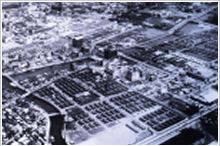
Around Kannai, Kamaboko barracks were lined up one after another on the burnt ruins. (around 1950)
In Yokohama City, with the city planning based on the Yokohama International Port Construction Act enacted in 1950, the momentum to expand the requisition movement increased, and in August 1951, Kanagawa Prefecture and the Yokohama Chamber of Commerce established the Yokohama City Reconstruction and Construction Conference together with the Chamber of Commerce and Industry, and started a full-scale campaign to dismiss the requisition.
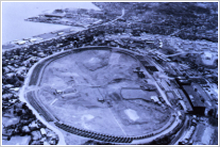
The Negishi Racecourse district, which was used as a golf course and heliport for U.S. military personnel. (Showa 20s)
In September 1951, the Peace Treaty (reconciliation treaty) and the former Japan-US Security Treaty were concluded, and in 1952, based on the administrative agreement between the United States and Japan, the requisition area in the city was renewed to the U.S. military. Will be provided.
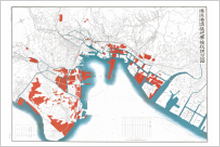
Requisition site (red location) at the time of the establishment of the Yokohama City Reconstruction and Construction Conference
(Aug 1951 Requisition Status Map of Areas adjacent to Yokohama Port)
On the other hand, with the entry into force of the Peace Treaty in 1952, Japan and the United States agreed to a relocation plan to consolidate and relocate facilities in the center of the city to nearby facilities, and many facilities located in urban areas such as the Yokohama Customs and the Yamashita Park Residential Area were returned.
Furthermore, in 1957, the withdrawal of the U.S. Forces Ground Fighting Unit in Japan was announced, and the Tana Ammunition Storage (now Children's Country) was returned.
| Showa | Major Events |
|---|---|
| 27 years | April 28: Peace Treaty, Former Security Treaty, Administrative Agreement Effective July 26: Signing of the Japan-U.S. facility area agreement |
| 28 years | July 27: Signing of the Korean War Arms Agreement December 5: Return of the Logistics Headquarters in Japan (JLC) (Yokohama Customs) |
| 29 | July 1: Established the Defense Agency, launched the SDF |
| 31 years | December 18: Membership of the United Nations |
| 32 years | June 21: Kishi Eisenhower Joint Statement |
| 33 years | May 10 ・ ・ ・ ・ 100th Anniversary Commemorative Ceremony June 30: Return of JLC Procurement Department Office (Yokohama Port Opening Memorial Hall) |
| 35 years | January 19: Signing of New Security Treaty and Status Agreement (effective June 23) June 15: Return of the Yamashita Park Residential Area |
| 36 years | March 31: Establishment of Yokohama City Council Requisition Promotion Executive Committee May 5: Return of Tana Ammunition Storage |
Inquiries to this page
Base Countermeasures Section, Urban Development Bureau Planning Department
Telephone: 045-671-2168
Telephone: 045-671-2168
Fax: 045-663-2318
Email address: tb-kichitaisaku@city.yokohama.lg.jp
Page ID: 113-713-958







